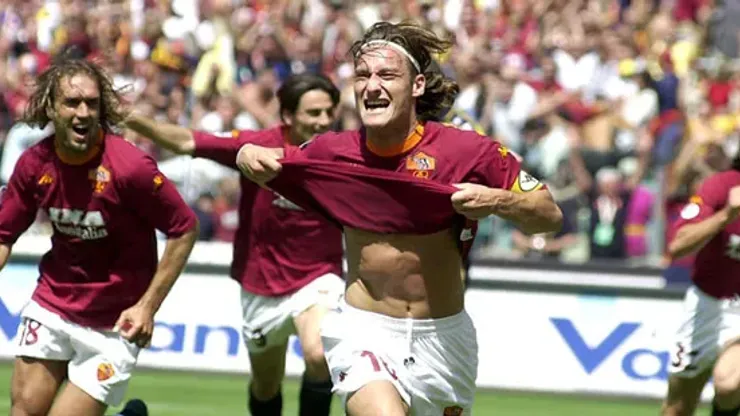As part of a series of the greatest team of the 2000s, the first team to start the list will be the Scudetto winning AS Roma side of the 2000-2001 season. As the last Roma side to win the Scudetto, they had a superb tactician in Fabio Capello leading the side and had players hitting their highest form.
To start the season, Capello was given funds to spend, and he spent over 50 million euros on proven players in Walter Samuel, Emerson, and Gabriel Batistuta. In signing a center-back, a central midfielder and a striker, Capello essentially instilled a new spine into the side. Yet, despite this, Emerson missed the first half of the season due to a serious injury. In this season, many players truly stepped up and performed at a level never seen from them before. This was the first true world-class season from Francesco Totti, while Vincent Candela stepped up as a quality left wing-back for the side. Here are some of the interesting tactical features of the Roma side.
1. The central midfielders
The injury to Emerson meant Tomassi and Christian Zanetti were Roma’s first choice central midfield pairing in a 3-4-1-2 formation. Both, in truth, were far from spectacular players. They did their defensive jobs without much fuss as highly disciplined central midfielders. As none of the front three in Totti, Batistuta and one of Marco Delvecchio or Vincenzo Montella tracked back, the two central midfielders prevented space in the center of the pitch for the opposition to attack.
2. The wing-backs
Vincent Candela and Cafu performed admirably as wing-backs during Roma’s Scudetto winning season. By this time, Cafu was a superb right-back, having captained Brazil to a World Cup in 1994 and leading them to another final in 1998. Cafu was Roma’s assist leader in Serie A, amassing 10 assists during this season. Cafu was what you would expect in a Brazilian full-back, good defensively and very good going forward. Cafu and Roberto Carlos were the true start of attacking full-backs as we see now, including the likes of Dani Alves and Marcelo, among others in recent seasons. Candela, obviously, was not as well-known. While Cafu performed admirably offensively and defensively, Candela did more of an unspectacular job. Despite this, he still managed to score three goals during the season.
3. Strikers
Batistuta was an inspired signing, as his 20 goals led Roma to the Scudetto. In truth, this was his last great season as a striker, as his next season saw him score just six goals. One of the main problems of the side was choosing Batistuta’s strike partner, between Montella and Delvecchio. Delvecchio started the season, as the classic tall targetman holding play up and performing well for the team. As the season went on, however, Montella’s scoring record off the bench meant he started games. Montella was a completely different type of player, as a fast poacher. Delvecchio only scored three goals in the entirety of the Serie A season, while Montella was Roma’s second top scorer, with 14 goals in the league.
4. The Defense
Looking across the great teams throughout the 2000s, there haven’t been many which featured a three-man defense. This Roma side played with three center-backs, and probably succeeded due to the suitability of the players at the side’s disposal. Walter Samuel, who was signed in the summer, slotted into the left-sided role (as he was left-footed) and quite strong. On the right side, Zebina was also strong and played on his natural side. One of Aldair and Antonio Zago played in the center. Aldair or Zago played the role of the extra man when against a two-man attack (as was common at the time, such as a 4-4-2) and carried the ball out from the back. Defensively, the side was superb in its organization. If one wing-back was passed on the flank, that side’s center-back would move out and become a right or left-back. The other two center-backs would almost become natural center-backs and the opposite sided wing-back would come back to play as a natural fullback. For example, if Candela was beaten down the left, Samuel would move out left, Zago and Zebina would function as regular center-backs, and Cafu would tuck in to play as a right-back, forming a back four.
5. Il Capitano
Lastly, how would a Roma side be complete without a mention of their captain, Totti? At 24, Totti had a very good season, even though it was not his best in a Roma shirt. The captain was superb in terms of both supplying goals and scoring them throughout the season. With the defensive cover provided by Javier Zanetti and Damiano Tommasi, Totti performed his trequartista role behind the forwards superbly.
The only regrets in this superb season for the side may come in the cup competitions. Roma were dumped out of the UEFA Cup and the Coppa Italia in the Round of 16. This season was the best from this squad, as they finished second in the following season, before a disappointing season in the 2002-2003 season, finishing in eighth place. Nevertheless, the likes of Batistuta, Montella, and Totti epitomized one of the greatest attacking tridents seen, as they all scored in the penultimate game of the season against Parma, to win Roma the Serie A.
200+ Channels With Sports & News
- Starting price: $33/mo. for fubo Latino Package
- Watch Premier League, Women’s World Cup, Euro 2024 & Gold Cup
The New Home of MLS
- Price: $14.99/mo. for MLS Season Pass
- Watch every MLS game including playoffs & Leagues Cup
Many Sports & ESPN Originals
- Price: $10.99/mo. (or get ESPN+, Hulu & Disney+ for $14.99/mo.)
- Features Bundesliga, LaLiga, Championship, & FA Cup
2,000+ soccer games per year
- Price: $5.99/mo
- Features Champions League, Serie A, Europa League & Brasileirāo
175 Premier League Games & PL TV
- Starting price: $5.99/mo. for Peacock Premium
- Watch 175 exclusive EPL games per season






